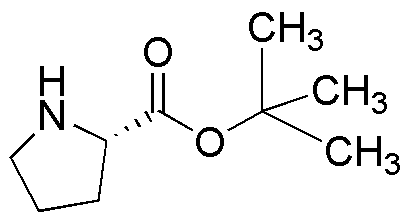L-Proline tert-butyl ester is widely utilized in research focused on:
- Synthesis of Peptides: This compound serves as a valuable building block in peptide synthesis, allowing researchers to create specific sequences for pharmaceuticals and biologically active compounds.
- Chiral Auxiliary in Organic Reactions: It acts as a chiral auxiliary, enhancing the selectivity of reactions in asymmetric synthesis, which is crucial for producing enantiomerically pure compounds in medicinal chemistry.
- Drug Development: The ester form improves the solubility and bioavailability of proline derivatives, making it beneficial in the formulation of new drugs.
- Biochemical Research: It is used in studies involving protein folding and enzyme activity, helping scientists understand the role of proline in biological systems.
- Material Science: This compound is explored for its potential in developing new polymers and materials due to its unique structural properties.
General Information
Properties
Safety and Regulations
Applications
L-Proline tert-butyl ester is widely utilized in research focused on:
- Synthesis of Peptides: This compound serves as a valuable building block in peptide synthesis, allowing researchers to create specific sequences for pharmaceuticals and biologically active compounds.
- Chiral Auxiliary in Organic Reactions: It acts as a chiral auxiliary, enhancing the selectivity of reactions in asymmetric synthesis, which is crucial for producing enantiomerically pure compounds in medicinal chemistry.
- Drug Development: The ester form improves the solubility and bioavailability of proline derivatives, making it beneficial in the formulation of new drugs.
- Biochemical Research: It is used in studies involving protein folding and enzyme activity, helping scientists understand the role of proline in biological systems.
- Material Science: This compound is explored for its potential in developing new polymers and materials due to its unique structural properties.
Documents
Safety Data Sheets (SDS)
The SDS provides comprehensive safety information on handling, storage, and disposal of the product.
Product Specification (PS)
The PS provides a comprehensive breakdown of the product’s properties, including chemical composition, physical state, purity, and storage requirements. It also details acceptable quality ranges and the product's intended applications.
Certificates of Analysis (COA)
Search for Certificates of Analysis (COA) by entering the products Lot Number. Lot and Batch Numbers can be found on a product’s label following the words ‘Lot’ or ‘Batch’.
*Catalog Number
*Lot Number
Certificates Of Origin (COO)
This COO confirms the country where the product was manufactured, and also details the materials and components used in it and whether it is derived from natural, synthetic, or other specific sources. This certificate may be required for customs, trade, and regulatory compliance.
*Catalog Number
*Lot Number
Safety Data Sheets (SDS)
The SDS provides comprehensive safety information on handling, storage, and disposal of the product.
DownloadProduct Specification (PS)
The PS provides a comprehensive breakdown of the product’s properties, including chemical composition, physical state, purity, and storage requirements. It also details acceptable quality ranges and the product's intended applications.
DownloadCertificates of Analysis (COA)
Search for Certificates of Analysis (COA) by entering the products Lot Number. Lot and Batch Numbers can be found on a product’s label following the words ‘Lot’ or ‘Batch’.
*Catalog Number
*Lot Number
Certificates Of Origin (COO)
This COO confirms the country where the product was manufactured, and also details the materials and components used in it and whether it is derived from natural, synthetic, or other specific sources. This certificate may be required for customs, trade, and regulatory compliance.


